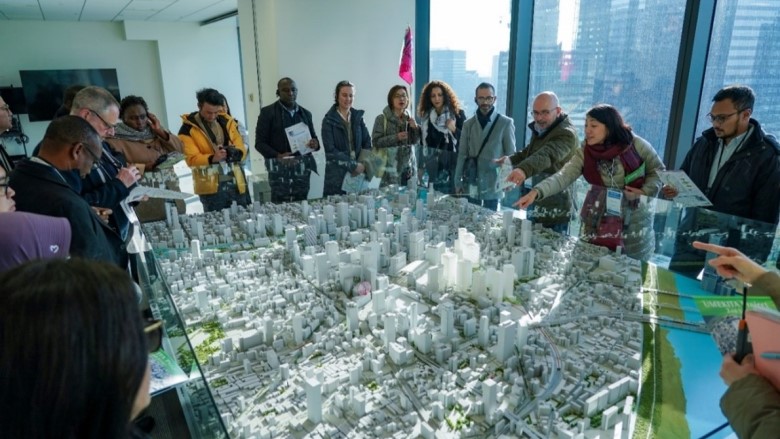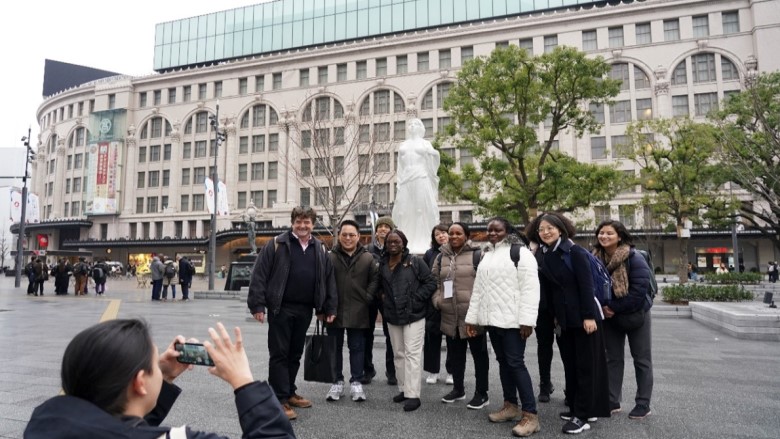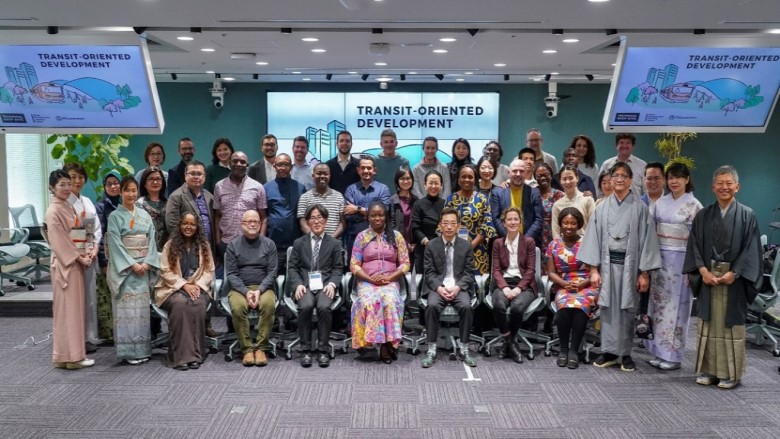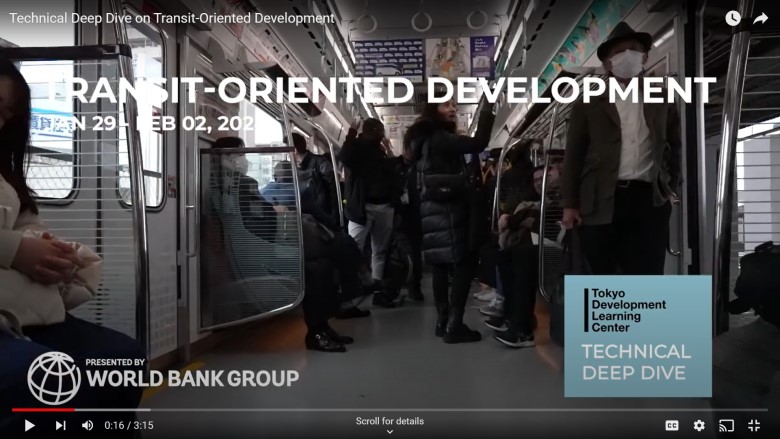Anchored on the concept of creating neighborhoods that are compact, walkable, energy-efficient with mixed-use spaces and communities, TOD promotes urban regeneration, local economic development, social inclusion, and livability. TOD can also be a solution to the challenges of climate change and global energy security as it greatly reduces the dependence on driving and promotes more energy efficient transport systems, including walking, cycling, and public transport system. Many cities all over the world pursue this urban development model to address their urbanization challenges. There is therefore great interest in learning more about the planning, policy, institutional framework, implementation, and financial aspects of TOD.
The objective of the Technical Deep Dive (TDD) on TOD, held between January 29 to February 2, 2024, was to provide participants with an opportunity to develop a deeper understanding of TOD as part of the overall urban planning and policy framework. Through Japanese case studies, the TDD showcased TOD driven urban regeneration, innovative financing and development mechanisms, and application of green TOD principles hinged on the concept of value for money, sustainability, resilience, social inclusion, and sound governance. Participants also learned about the spatial, social, and economic impacts of land-based development through case studies and knowledge exchange.
TOD Challenges
Weak institutional framework and coordination
TOD is multi-sectoral and involves diverse actors. The TDD participants cited the critical need for all stakeholders to work together as a collective. They observe for example that urban department and the transport agency do not always coordinate effectively. Decision making on which government entity leads is often opaque. Additionally, in decentralized contexts, it is not uncommon that local governments have little capacity, limited access to capital outside of central transfers and inconsistent reporting relationship with the central government. Lastly, communication and involvement of citizens engagements tend to end in conflict rather than facilitating consensus.
Lack of financial instruments and involvement of private sector
Many delegations reported that they face the challenge of private sector involvement and structuring of PPP arrangements in TOD projects. What are critical ingredients to attracting private finance in such programs? Are the expected revenue streams sufficient to encourage private firms to participate? While some participants are familiar with land value capture concepts and regulations and provide a basis for implementation, these are not deployed in the design of TOD projects due to local capacity issues, lack of trust and transparency.
Little attention to resilience and environmental benefits of TOD
TOD can bring huge potential benefits to climate change adaptation and mitigation. The participants believed that there is limited progress in this respect due to lack of institutional capacity. There are limited planning capabilities in the application of integrated land use, green mobility, and climate-resilient infrastructure principles. Therefore, enhancing the institutional capacity for resilient and green urban transport development is critical.
Good TOD practices in Japan
The following sites were visited during this TDD:
- Green Umekita, Osaka
Umeda and Osaka station together form the largest transit node in Western Japan. It has gone through several major redevelopments and is expected to continue to do so in the future. Daily ridership of total 9 stations around Umekita project area is about 2.4 million passengers, connecting other local transit nodes and promoting innovation and knowledge hubs. Umekita is a new regeneration project in front of Umeda and Osaka Station, embracing sustainability by incorporating large green spaces and solutions into its station front design, thus creating vibrant, livable, and walkable space.

- Vibrant Namba, Osaka
Namba area sits at the end of Osaka City’s main street, Midosuji Avenue, and has developed into a major commercial area centering on the shopping street, department stores, and the terminal stations of numerous railway lines. The two public-space revitalization projects in Namba area (Namba plaza and Midosuji Ave) showcase bottom-up initiative by the local business community to regenerate the dense transit node into human-centered space promoting social integration and walkability as well as non-motorized transport infrastructure. They show how sharing a vision by the city government and other stakeholders facilitates implementation.The Museum of Urban Design and Lifestyle, owned and operated by Urban Renaissance Agency (UR), is in Akabanedai, located in the outskirts of Tokyo.

- Senri-Chuo, Osaka
Senri-Chuo Station in the center of the Northern Osaka Area features convenient access to Shin-Osaka, Umeda, and Namba on the same train line, each of which are 15, 20, and 30 minutes away, respectively. Senri New Town located at Senri-Chuo presents the first large-scale integrated urban and mobility development in 1960s, in response to the exploding population in metropolitan Osaka at the time. In its construction, operation and regeneration, there is a strong coordination among the national entities, i.e., Urban Renaissance Agency and Osaka Prefectural Government, the local government, and the transport operator. Currently, regeneration development projects are planned at the station area to reinvigorate local economic development and enhance social inclusion.
Key takeaways
Many participants shared that the TDD gave them a deeper understanding of TOD principles and TOD as a strategic approach to urban development. TOD aims to foster compact, mixed-use urban development for pedestrians, bring jobs, helps in housing development, facilitates delivery of urban services. The following are some key takeaways from the TDD.
1) Implementing TOD requires establishing a dedicated unit. The Osaka cases featured the role of Urban Renaissance Agency (UR), a type of public institution dedicated to land consolidation and management. Umekita land-based development case along transit nodes confirmed how UR played an essential role in managing land and trunk infrastructure development at the early phase, and also served as an advisor and coordinator for both central government and private sector. Another example of effective silo-breaking institutional set up was the Osaka City Planning Bureau, jointly established by Osaka Prefecture and Osaka City, which plays a central role in formulating urban development policies and dedicated in implementing strategic infrastructure projects in a speedy manner.
2) Well-structured financing from the public and the private sectors is critical to TOD projects.
TOD serves as a powerful tool for economic competitiveness, enhancing access to services and jobs and fostering local economic growth by linking transit systems with urban development. Recognizing this potential, the TDD Thematic session explored key aspects of TOD implementation, including land use regulations, zoning, land management tools, and financing mechanisms such as Land-value capture and tax-increment financing. In Japan, TOD model offers a unique perspective, showcasing how strong collaboration between real estate developers and mass transit operators can unlock the full potential of TOD. This seamless integration, often seen with private transit operators also being real estate developers themselves, exemplifies the successful realization of urban and transport integration, mostly financed through private scheme.
3) Private sector involvement and community engagement are important in creating human-centered, livable space. Understanding the crucial role of private sector involvement in creating green, walkable and comfortable public spaces as well as attractive commercial area around the station alongside housing developments, leveraging TOD principles and increase ridership and land value is key. The case studies also emphasized how urban regeneration efforts can create mutual benefits for businesses, residents, and the environment by promoting win-win situations where businesses find new markets and opportunities.
4) National government sets strategic planning framework while leaving space for local government to implement projects based on their city grand design. Land-based development in Japan gets incentivized through a clear national government urban planning instrument. The ‘Urban Renewable Priority Zones’ defines urban regeneration priority zones and provide financial and legal support for Land-value Capture. The incentives include special exceptions for floor area ratio and relaxed taxation. In the case of Osaka, the city’s Urban Planning Grand Design (Machizukuri) defined city-wide vision and visions for each targeted revitalization area, as shown in two site visit locations - Umekita and Namba.
Participant comments:
“This opportunity allowed me to better understand the TOD method in the field of Urban Planning, with a view to its application in the framework of the Douala Urban Mobility Project. TOD is a strategic approach to planning and design that aims to foster compact, mixed-use urban development for pedestrians and general users, closely connected with public transit such as BRT. It's about bringing jobs, housing, urban services and amenities together around transit stations. Drawing on Japanese examples, we have identified key messages on urban regeneration, innovative financing mechanisms and the application of GREEN TOD principles. These principles encompass value for money, sustainability, resilience, social inclusion and effective governance. I was particularly struck by the involvement and engagement of the private sector in the development of cities according to this approach. This requires real territorial marketing and ownership by all stakeholders, whether they are administrative authorities, populations or the private sector.”
(Ms. Prisca Lablonde, Country delegation from Cameroon)
Acknowledgements
TDLC is grateful to Osaka City for hosting the TDD and for sharing their best-case studies during several sessions of the TDD. It is also thankful to the UR for sharing its extensive experience and knowledge on land management for large-scale urban regeneration projects in transit nodes, in addition to their knowledge on large-scale urban planning to secure affordability and answer housing needs along the corridor development.

